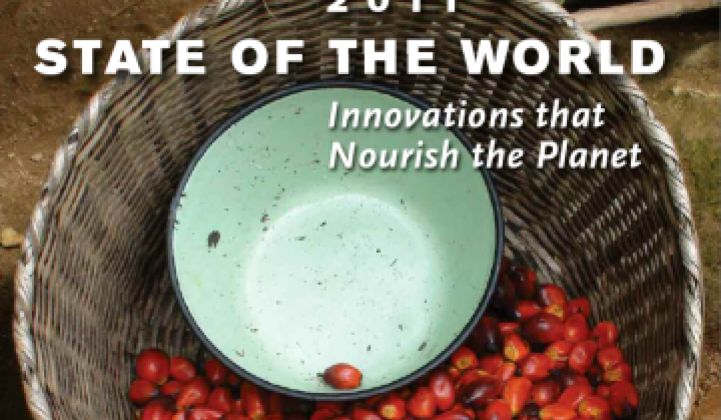Enormously rich in natural resources, Africa is far richer in people urgently in need of food and energy -- and those needs offer a huge opportunity for greentech entrepreneurs.
That opportunity informs 2011 State of the World from Worldwatch Institute (WWI), a two-years-in-the-making report financed by the Bill and Melinda Gates Foundation. It catalogues ways that innovations in information technology, renewable energy and business finance can alleviate hunger, lift people out of poverty and protect the environment at a profit to entrepreneurs who deliver solutions.
“What we really wanted to do,” said senior researcher Danielle Nierenberg, “was focus the analysis around innovations, innovations that are working, innovations that can be scaled up and replicated elsewhere, not just in Africa but in Latin America and Asia.”
That’s a pretty big market for ideas that prove workable.
“It’s not really about giving hand-outs anymore,” said Washington-based writer Samuel Fromartz, who authored a chapter in the report. “The whole idea is to create a sustainable model.” In Zambia’s capital, “you see all these Chinese banks,” Fromartz said. “They see a huge opportunity in Africa.”
“If I was a smaller investor,” Nierenberg said, “I’d be really interested in this book” because it describes “the importance of information technology” to African farmers. “What I really discovered,” Nierenberg said of her research travels to Africa, is that “farmers are businesswomen and they’re businessmen.” What they need, she saw firsthand, is access to information that affects their businesses and marketplaces.
Nierenberg explained that cell phones are now omnipresent in rural Africa, so innovative ways of delivering “access to mobile banking or information about livestock diseases or access to information about prices at the market” via cell phones will find immediate acceptance and African farmers will pay for such services because they bring returns.
Nierenberg cited, as an example of what is possible, a joint venture by cell service provider Mobile Transactions and cotton multinational Dunavant in making electronic credit available to Zambian cotton farmers, to the increased prosperity of all three.
Fromartz said the rollout of Africa’s mobile networks was a big risk but that they “are huge businesses in Africa now” and “showing the opportunity in what’s called the bottom of the pyramid.” As an example, he described how Zambian banks provided a Dunavant-backed consortium of small farmers with loans for tractors. “The repayment rate was 100%,” Fromartz said, “and they repaid the three-year loans within one year.”
Some observers have suggested the returns from such microloan-like financial arrangements may be less than those from commercial ventures but if the players have a vested interest, the return rate may be somewhat secondary. The WWI report is intended to help investors recognize this.
Nierenberg described the use of solar drip irrigation systems in rural Niger, from which women farmers were able to increase their incomes dramatically “over just six months” by both increasing their yields and varying their crops. “They were making $300 per year and they are now making $1000 or $1,500 per year,” she said. “If solar was my passion and I was an investor,” Nierenberg said, supplying the $50-to-$350 solar irrigation system kits would be an entrepreneurial opportunity. “The payoffs are so big.”
While benefits to the women farmers are surely as Nierenberg described, outside investors have not always found rates of return commensurate with other -- less risky -- uses of capital. But players already on the ground with vested interests in scaling markets might see less risk and more opportunity. Produce exporters could increase supplies and varieties by financing solar drip irrigation kits for growers. Solar manufacturers could build volume and drive down costs through economies of scale.
There are also ancillary opportunities in introducing these innovations. The need for maintenance and repair of the solar drip irrigation systems, Nierenberg pointed out, means there will be a need for educating users and providing them with services. “We’re talking millions of people,” Nierenberg said, some 80 million in the semi-arid regions of Africa alone.
Fertilizer and agro-chemical companies in Africa learned a similar lesson from the introduction of advanced fertilizers and herbicides and of biotech-designed seeds. “They were tapped out in terms of selling to big industrial farmers. That market was totally saturated,” Fromartz said, but “that’s only fifteen to twenty percent of the ag market. The rest are the small-holder farmers, so the question becomes ‘how do you reach them?’”
It was done by “training and partnering with farmers to become agricultural agents,” Nierenberg explained. With big agricultural entities like CNFA and AGMARK “investing in existing agro-dealers and helping train new ones,” Kenya now has about 2,000 such agents and backers there expect to double that number in the next two years. Each agro-dealer serves some 500 families, amounting to a customer base of up to 20,000 people.
Loans of no more than $1,000 put the agents in business. Once situated, they expand their impact by providing services ranging from veterinary care to farm machinery sales. It’s a way “to make farmers more entrepreneurial,” Nierenberg said.
Nierenberg urges proceeding cautiously because “not every innovation is going to work in every village or country,” she said. “But I see a lot of hope and I see a lot of success. There’s huge opportunity there, not only to help people, but to make money.”



